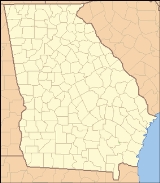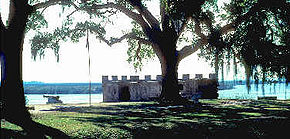
Fort Frederica National Monument
Encyclopedia

James Oglethorpe
James Edward Oglethorpe was a British general, member of Parliament, philanthropist, and founder of the colony of Georgia...
between 1736 and 1748 to protect the southern boundary of the British colony of Georgia
Province of Georgia
The Province of Georgia was one of the Southern colonies in British America. It was the last of the thirteen original colonies established by Great Britain in what later became the United States...
from Spanish
Spain
Spain , officially the Kingdom of Spain languages]] under the European Charter for Regional or Minority Languages. In each of these, Spain's official name is as follows:;;;;;;), is a country and member state of the European Union located in southwestern Europe on the Iberian Peninsula...
raids. About 630 British troops were stationed at the fort. A town of up to 500 colonial residents had grown up outside the fort. The town was named Frederica, after Frederick, Prince of Wales
Frederick, Prince of Wales
Frederick, Prince of Wales was a member of the House of Hanover and therefore of the Hanoverian and later British Royal Family, the eldest son of George II and father of George III, as well as the great-grandfather of Queen Victoria...
, son of King George II. The monument was listed on the National Register of Historic Places
National Register of Historic Places
The National Register of Historic Places is the United States government's official list of districts, sites, buildings, structures, and objects deemed worthy of preservation...
in 1966.
History
In the early 18th century, Europeans called the land lying between British South CarolinaProvince of South Carolina
The South Carolina Colony, or Province of South Carolina, was originally part of the Province of Carolina, which was chartered in 1663. The colony later became the U.S. state of South Carolina....
and Spanish Florida
Spanish Florida
Spanish Florida refers to the Spanish territory of Florida, which formed part of the Captaincy General of Cuba, the Viceroyalty of New Spain, and the Spanish Empire. Originally extending over what is now the southeastern United States, but with no defined boundaries, la Florida was a component of...
the Debatable Land. Today's state of Georgia was then the center of a centuries-old imperial conflict between Spain and Britain. After the philanthropist James Oglethorpe
James Oglethorpe
James Edward Oglethorpe was a British general, member of Parliament, philanthropist, and founder of the colony of Georgia...
founded the colony of Georgia in 1733, to provide a place where poor debtors could settle, colonists from England and Scotland, and refugees from the German
Germany
Germany , officially the Federal Republic of Germany , is a federal parliamentary republic in Europe. The country consists of 16 states while the capital and largest city is Berlin. Germany covers an area of 357,021 km2 and has a largely temperate seasonal climate...
Palatinate built Fort Frederica in 1736 to defend their new territory. They named Frederica for Frederick, Prince of Wales
Frederick, Prince of Wales
Frederick, Prince of Wales was a member of the House of Hanover and therefore of the Hanoverian and later British Royal Family, the eldest son of George II and father of George III, as well as the great-grandfather of Queen Victoria...
, (1707–1751). The name was feminized to distinguish it from Fort Frederick
Fort Frederick Heritage Preserve
Fort Frederick Heritage Preserve is a property located in Port Royal, South Carolina. Situated along the Beaufort River, the Preserve contains the remains of Fort Frederick. Also known as "Fort Prince Frederick", the tabby fort was built by the British between 1730 and 1734 to defend against a...
in South Carolina.
In the 1742 battles of Bloody Marsh
Battle of Bloody Marsh
The Battle of Bloody Marsh took place on July 18, 1742 between Spanish and British forces, and the latter were victorious. Part of the War of Jenkin's Ear, the battle was for control of the road between the British forts of Frederica and St. Simons, to control St. Simons Island and the forts'...
and Gully Hole Creek
Battle of Gully Hole Creek
The Battle of Gully Hole Creek was a skirmish in 1742 on St. Simons Island, Georgia, between Spanish troops from the Spanish colony of Florida and British colonial troops on St. Simons Island. It was won by the British...
, forces under Oglethorpe successfully repulsed Spanish attempts to retake St. Simons Island. Afterward the Spanish no longer threatened the colony; in 1749 the government disbanded the garrison
Garrison
Garrison is the collective term for a body of troops stationed in a particular location, originally to guard it, but now often simply using it as a home base....
at Frederica. Soon the village fell into economic decline and by 1755, it was mostly abandoned. The town survived a fire in 1758, but after a few more years, it was abandoned.
Fort Frederica was documented and authorized as a National Monument
U.S. National Monument
A National Monument in the United States is a protected area that is similar to a National Park except that the President of the United States can quickly declare an area of the United States to be a National Monument without the approval of Congress. National monuments receive less funding and...
on May 26, 1936, under the Franklin D. Roosevelt
Franklin D. Roosevelt
Franklin Delano Roosevelt , also known by his initials, FDR, was the 32nd President of the United States and a central figure in world events during the mid-20th century, leading the United States during a time of worldwide economic crisis and world war...
administration during the Great Depression
Great Depression
The Great Depression was a severe worldwide economic depression in the decade preceding World War II. The timing of the Great Depression varied across nations, but in most countries it started in about 1929 and lasted until the late 1930s or early 1940s...
. During this period, the Works Progress Administration
Works Progress Administration
The Works Progress Administration was the largest and most ambitious New Deal agency, employing millions of unskilled workers to carry out public works projects, including the construction of public buildings and roads, and operated large arts, drama, media, and literacy projects...
(WPA) sponsored numerous surveys of historic areas and buildings across the country to identify, document and protect the resources for the future, as well as to provide employment.
Starting in 1947, the National Park Service
National Park Service
The National Park Service is the U.S. federal agency that manages all national parks, many national monuments, and other conservation and historical properties with various title designations...
and the Ft. Frederica Association, a citizens' interest group, sponsored a series of archaeological investigations at the Frederica site. Using information from 18th-century maps and journals as guides, the archaeologists excavated sections of the fort and village. By correlating the archaeological data with the historic documents and excavating remains of structures, the archaeologists have provided important insight into Frederica's past and colonial history, a complex time of international rivalries.
As an historic area under the National Park Service, the National Monument was listed on the National Register of Historic Places
National Register of Historic Places
The National Register of Historic Places is the United States government's official list of districts, sites, buildings, structures, and objects deemed worthy of preservation...
on October 15, 1966. Fort Frederica is open to the public.
Related sites
- Battle of Bloody MarshBattle of Bloody MarshThe Battle of Bloody Marsh took place on July 18, 1742 between Spanish and British forces, and the latter were victorious. Part of the War of Jenkin's Ear, the battle was for control of the road between the British forts of Frederica and St. Simons, to control St. Simons Island and the forts'...
- Battle of Gully Hole CreekBattle of Gully Hole CreekThe Battle of Gully Hole Creek was a skirmish in 1742 on St. Simons Island, Georgia, between Spanish troops from the Spanish colony of Florida and British colonial troops on St. Simons Island. It was won by the British...
- Castillo de San Marcos National MonumentCastillo de San MarcosThe Castillo de San Marcos site is the oldest masonry fort in the United States. It is located in the city of St. Augustine, Florida. Construction was begun in 1672 by the Spanish when Florida was a Spanish territory. During the twenty year period of British possession from 1763 until 1784, the...
- Fort Caroline National Memorial
- Fort King GeorgeFort King GeorgeFort King George was a fort located in the U.S. state of Georgia. The fort was built in 1721 along the Altamaha River and served as the southernmost outpost of the British Empire in the Americas until 1727. The fort was constructed in what was then considered part of the colony of South Carolina,...
- Fort Matanzas National MonumentFort Matanzas National MonumentCommemorated in 1924, Fort Matanzas National Monument is a United States National Monument run by the National Park Service. The Monument consists of a 1740 Spanish fort, Fort Matanzas, and about 100 acres of salt marsh and barrier islands along the Matanzas River on the northern Atlantic coast...
- Fort Morris State Historic Site
- Wormsloe Historic SiteWormsloe Historic SiteThe Wormsloe Historic Site is a state historic site near Savannah, Georgia, in the southeastern United States. The site consists of protecting part of what was once the Wormsloe Plantation, a large estate established by one of Georgia's colonial founders, Noble Jones...

